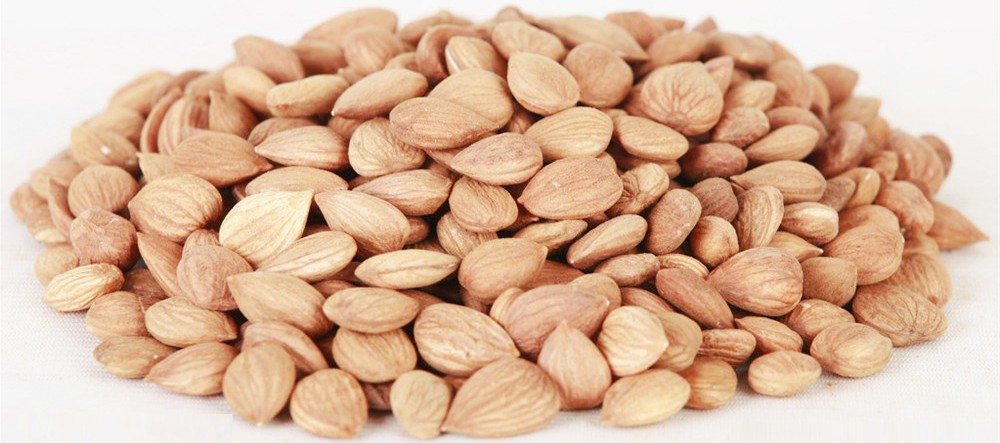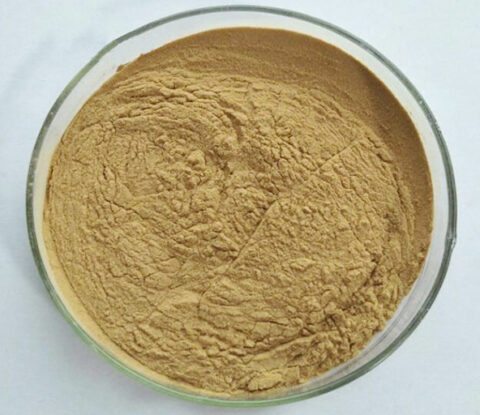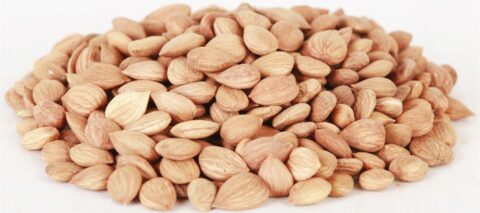
Bitter Apricot Seed extract Powder, Bitter Almond Extract(Ku Xing Ren) 10:1, 20:1, 50:1 TLC
Harvest mature fruits in summer, remove the flesh and shell, remove the seeds, and sun dry them. Bitter Apricot Seed extract has the properties of reducing qi, relieving cough, relieving asthma, moistening intestines, and promoting bowel movements. Used for coughing, wheezing, chest fullness, phlegm accumulation, intestinal dryness and constipation.
Bitter Apricot Seed extract Powder, Bitter Almond Extract(Ku Xing Ren) 10:1, 20:1, 50:1 TLC
【Botanical source】: Prunus armeniaca L.varansu Maxim., Prunus sibirica L., Prunus mandshurica ( Maxim.Koehne or Prunus armeniaca L.
【Other names】: Ku Xing Ren, Semen Armeniacae Amarae, Xing Ren, Bitter Apricot Seed, Semen Armeniacae Amarum
【Part used】: The dried ripe seeds of the deciduous arbor plant Prunus armeniaca L.varansu Maxim., Prunus sibirica L., Prunus mandshurica ( Maxim.Koehne or Prunus armeniaca L. of family Rosaceae. Mainly produced in Inner Mongolia, Jilin, Liaoning, Hebei, Shanxi, and Shaanxi of China.
【Functions in TCM】: The main therapeutic functions include reducing qi, stopping cough, relieving asthma, moistening the intestines, and promoting bowel movements. Used for coughing and wheezing, chest fullness and phlegm accumulation, blood deficiency and fluid depletion, intestinal dryness and constipation.
【Specification】: 10:1, 20:1, 50:1 TLC, Amygdalin(CAS. #:29883-15-6) 10%, 50%, 70%, 98% HPLC
【Appearance】: Light brownish or offwhite powder
【Particle size】: 95% pass 80 mesh size

Bitter Apricot Seed extract Powder(Ku Xing Ren) Production Flowchart
Bitter apricot seeds raw materials – natural air drying–Coarse powder(40 mesh) -Low temperature water extraction – 1st Reflux Extraction(10 times water,2 Hrs) – 2nd Reflux Extraction8 times water,1.5 Hrs) – 3rd Reflux Extraction(6 times water,1 Hrs) – Extraction Solution-combine&Filtrate-Concentrate-Extractum-spray drying – screening – packaging – detection of physical and chemical indicators – warehousing
Specification of Bitter Apricot Seed extract Powder(Ku Xing Ren)
| Item | Standard | Test method |
| Appearance | Light Brownish fine powder | Visual & Organoleptic |
| Specification | 10:1 | TLC |
| Particle size | 80 mesh | Pass 80 mesh size screen |
| Ash | <13% | 2g/525℃/3hrs |
| Moisture | <7% | 5g/100℃/2.5hrs |
| Heavy metals | As <1.0ppm Pb<2.0PPM Hg<0.2ppm Cd<1.0ppm | Atomic Absorption |
| Microbiological Control | Total Plate Count<10,000cfu/g, Yeast & Mold<100cfu/g, E.Coli<10cfu/g. |
AOAC |
| Packing | 1kg/bag, 5kg/bag, or 25kg/fiber drum (D* H, 40*50cm),
It can also be packaged according to the requirements of customers, and all the packaging materials meet the standards of Chinese Pharmacopoeia 2010. |
|
Extended Reading
Chemical Composition of Bitter Apricot Seed (Ku Xing Ren)
It contains about 3% bitter almond glycoside, about 50% fatty oil (almond oil), protein, and various free amino acids. Amygdalin is affected by amygdalin and cherry blossom leaf enzymes in almonds β- Glucosidase hydrolysis generates hesperidin and amygdaline, followed by decomposition to form benzaldehyde and hydrocyanic acid.
Pharmacological Action of Bitter Apricot Seed (Ku Xing Ren)
1. Anticough and asthma relieving effects
Bitter Apricot Seed contain amygdalin, which can be hydrolyzed by intestinal microbial enzymes or amygdalin enzymes contained in bitter almonds themselves in the body, producing trace amounts of hydrogen cyanide and benzaldehyde. It has an inhibitory effect on the respiratory center, achieving cough suppressive and asthma relieving effects. The Compendium of Materia Medica records that almonds have the ability to dispel wind and cold, as well as the ability to lower the qi and eliminate wheezing. Skilled in relieving cough, resolving phlegm, and relieving asthma, it has a strong targeted effect on the main symptoms of cough, excessive phlegm, and wheezing in the lung system. Therefore, ancient and modern doctors have used it as a lung medicine, regardless of internal injuries or external sensations, new and chronic diseases, and those involving the lungs. Using guinea pig in vitro organ experiments, almond water extract can reduce the sensitivity of organs to ammonia stimulation, counteract the excitatory effects of histamine, acetylcholine, and barium chloride on tracheal smooth muscle, and have a significant cough relieving effect. Using the SO2 induced cough method, it was demonstrated that after administering 1mg/kg, 10mg/kg, and 100mg/kg of amygdalin orally to mice for 30 minutes, their inhibition rates on cough frequency were 26%, 22.8%, and 25.3%, respectively. The effect of orally administered bitter almond extract at 48.3mg/kg is 39.7% stronger than that of an equal amount of bitter almond glycoside. Bitter almonds are beneficial for lung respiratory function due to their ability to promote the synthesis of pulmonary surfactant (PS). Bitter almonds not only promote PS synthesis, but also improve various physiological and biochemical indicators related to the lungs (such as lung plasma, lung water volume, total phospholipids in bronchoalveolar lavage, and pathological slices).
2. Effects on the digestive system
Bitter Apricot Seed has a bitter and astringent taste, and are rich in fatty oils. Fat oil can enhance the lubricating effect of intestinal contents on the mucosa, so almonds have the function of moistening the intestines and promoting bowel movements. Amygdalin is broken down by enzymes to form hydrogen cyanide, while also producing benzaldehyde, which can inhibit the activity of gastric protease and thus affect digestive function. The hydrolysate of gastric protease from the water-soluble part of almonds was administered to carbon tetrachloride treated rats at a dose of 500mg/kg. It was found that it could inhibit the increase of AST, ALT levels, and hydroxyproline content, as well as the prolongation of the dissolution time of immunoglobulin. The hydrolysate of gastric protease from the water-soluble part of almonds can inhibit the proliferation of rat liver connective tissue, but cannot inhibit the increase in AST and ALT levels caused by D-galactosamine.
3. Anti inflammatory and analgesic effects
The water extract of defatted Bitter Apricot Seed has an inhibitory effect on acetic acid induced writhing in mice and cotton ball induced granulomatous inflammation in rats. Using the method of rat foot joint edema, intravenous injection of 40mg/kg water-soluble protein components KR-A and KR-B5mg/kg of almond has an anti-inflammatory effect. The experiment using a mouse model of naphthoquinone induced pain showed that when KR-A or KR-B was administered intravenously at 5mg/kg, the pain inhibition rates were 40.7% and 58.2%, respectively. They have an oral intake of ED50 of 13.9mg/kg and 6.4mg/kg for carrageenan induced foot swelling in rats. The mouse hot plate method and acetic acid writhing method confirmed that amygdalin has analgesic effects, but it is different from morphine analgesics. Benzaldehyde produced by the decomposition of amygdalin produces benzoin through the action of benzoin synthase. Benzoin has analgesic effects, so some people in China use bitter almonds to treat advanced liver cancer, which can relieve the pain of patients, and some even do not need to take painkillers.
4. Antitumor effect
In the early 20th century, amygdalin was first isolated from almonds, and in 1920, amygdalin was first used in the United States to treat tumors. Dr. Ernest Krebs was the first person in the United States to use amygdalin in medicine and referred to it as vitamin B17. Since the 1950s, although amygdalin has been widely used to treat tumors in countries such as the United States and Mexico, with the trade name vitamin B17 or laetrile, its anti-tumor effect has not been recognized by the FDA, and there has been controversy in the academic community, with two completely opposite views. The affirmative side believes that amygdalin is a vitamin B17 that has preventive and therapeutic effects on tumors, and proposes some theoretical and experimental data. If it is believed that anaerobic degradation of tumor cells is dominant, and the final product is lactic acid, a slightly acidic environment is conducive to improvement β- The activity of glucosidase promotes the decomposition of amygdalin into more benzaldehyde and hydrogen cyanide in tumor cells, resulting in a selective killing effect on tumor cells. On the contrary, it is believed that amygdalin is not a vitamin at all, has no anti-cancer effect, and is even a toxic substance. Although the anti-tumor effects of amygdalin are still debated, its manufacturing and use are legal in over 20 countries, including Belgium, Germany, Italy, Mexico, and the Philippines.
There have been numerous reports on the anti-tumor efficacy of almonds both domestically and internationally, but the results are not entirely consistent. Sato Zhaoyan (1979) reported that the crude extract of almond hot water had an inhibition rate of 50% -70% on the JTC-26 strain of human cervical cancer. The research results of Fang Wenlong et al. (1986) showed that the inhibition rate of bitter almond extract by intraperitoneal injection or gavage on liver cancer and sarcoma 180 was 61.7% -77.1%. The experimental results of Che Wenyi et al. (1987) showed that the anti-tumor active ingredients extracted from bitter almonds were intraperitoneally injected into transplanted liver cancer mice at 300mg/kg, 400mg/kg, and 600mg/kg, with tumor inhibition rates of 72.0%, 60.8%, and 51.0%, respectively. Allowing mice to freely consume bitter almonds can inhibit the growth of Ehrlich ascites cancer cells and prolong their survival. There are also reports that amygdalin can prevent and treat dimethylnitrosamine induced liver cancer, leading to a reduction in tumor size. However, Mai Weiqi et al. (1981) extracted amygdalin (10% aqueous solution) from bitter almonds for animal experiments, and the results showed that it had no antibacterial activity against mouse liver cancer, S180, etc. The human case study initiated by the American Cancer Institute (NCI) on the efficacy of amygdalin in cancer was completed in 1978 but no clear conclusions were drawn. In 1982, the United States conducted various cutting-edge clinical trials and concluded that Laetrile had no clinical value in treating cancer.
5. Hypoglycemic effect
Amygdalin has the effect of preventing and treating diabetes caused by the antineoplastic drug, Albiuret. Using the method of inducing hyperglycemia in mice with urea, it was demonstrated that pre intraperitoneal injection of 3g/kg amygdalin for 48 hours followed by blood glucose measurement. The results showed that amygdalin can specifically inhibit the increase in blood glucose caused by urea, and the intensity of action is related to the concentration of amygdalin in the blood.
6. Hypolipidemic effect
According to clinical reports, 24 patients with blood lipids ranging from 200 to 260 were given 100g of almonds daily as the main source of fat. After 3 weeks, their blood lipids decreased by an average of 10.1%. 85 patients with hyperlipidemia took 75g of almonds daily for 4 consecutive weeks, and continued to observe for another 4 weeks after discontinuing the medication. The results showed that almonds can significantly reduce blood lipid levels in patients with hyperlipidemia, with the most significant reductions being in serum total cholesterol (TC) and low-density lipoprotein cholesterol (LDL-C), which decreased by 10.6% and 8.1% respectively. At the same time, there was no significant change in high-density lipoprotein cholesterol (HDL-C) in patients, while apolipoprotein B (Apo B) decreased significantly and apolipoprotein A1 (Apo A1) increased significantly. Spiller (1990) believed that monounsaturated fatty acids in almonds can help reduce mildly elevated blood lipids in patients without the need for strict dietary restrictions.
7. Cosmetic effects
According to the theory of lung combined skin and hair, in clinical practice, certain skin diseases can be treated through the method of promoting lung function, combined with the consumption of almonds, often achieving quick results. Modern research has shown that the fatty oil contained in bitter almonds can soften the skin’s stratum corneum, moisturize and care for the skin, protect nerve endings, blood vessels, and tissue organs, and inhibit and kill bacteria. In addition, HCN generated by enzymatic hydrolysis can inhibit the activity of tyrosinase in the body, eliminate pigmentation, freckles, black spots, etc., and thus achieve cosmetic effects.




